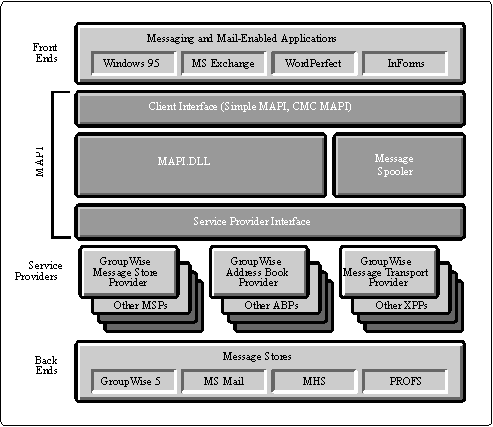MAPI Support in GroupWise 5
Articles and Tips: article
Technical Writer
GroupWare Division
01 Sep 1996
Describes the set of Message Application Programming Interface (MAPI) functions. Also tells how to access GroupWise properties through MAPI functions.
- Introduction
- MAPI support for messaging applications and service providers
- Accessing GroupWise Properties
Introduction
The Messaging Application Programming Interface (MAPI 1.0) is a set of object-oriented functions that provide messaging capabilities. Mail enabled applications use MAPI to create, transfer, and store messages, as well as handle complex addressing information. MAPI objects are data structures that support a set of properties and comply with the OLE component object model (COM), which requires that objects support one or more interfaces, or sets of functions.
GroupWise 5 offers extensive MAPI support by:
Interfacing with the Microsoft Exchange client
Interfacing with mail enabled MAPI applications such as WordPerfect and InForms
Supporting all MAPI clients
Supporting the client interface (Simple MAPI,CMC MAPI)
Interfacing with messaging and mail enabled applications
MAPI support for messaging applications and service providers
Figure 1: MAPI support for messaging applicaitons and service providers.

As illustrated above, MAPI allows messaging applications and mail enabled applications direct access to service providers. Messaging functions are called from the MAPI client interface.
The MAPI DLLs act as an object handler by selecting the provider and exposing objects to the client interface. Various messaging operations can be performed by calling methods in the exposed object.
Each service provider performs its functions according to a supporting messaging service which can include multiple message stores, address books, and transport providers. MAPI selects among message stores and transport providers as necessary. Multiple address books are independent of one another in the client, allowing the user to choose among them. The message spooler controls MAPI activities that run independently of the messaging application. The spooler works closely with the message stores and transport providers when transferring messages. Because the spooler monitors its activities internally, it is transparent to the client interface.
Accessing GroupWise Properties
Each message store is comprised of folders. Folders can contain other folders and messages, which may contain attachments. Folders, messages, and attachments all have properties. Examples of properties include the subject of a message, the user ID of the recipient, and the body of a message. Each property has a type (for example, STRING8, BINARY, UNICODE) and may have one or more values which you can use to narrow the focus of the property.
To access a property, you must use the IMAPIProp interface. Because IMAPIProp is derived from IUnknown, all IUnknown methods are available. For more information, see the MAPI Programmer's Guide.
In addition to predefined MAPI properties, MAPI allows message class defined properties which are in the range 68007FFF. For a list of Novell-defined MAPI properties, see the MAPI documentation in the GroupWise SDK.
* Originally published in Novell AppNotes
Disclaimer
The origin of this information may be internal or external to Novell. While Novell makes all reasonable efforts to verify this information, Novell does not make explicit or implied claims to its validity.